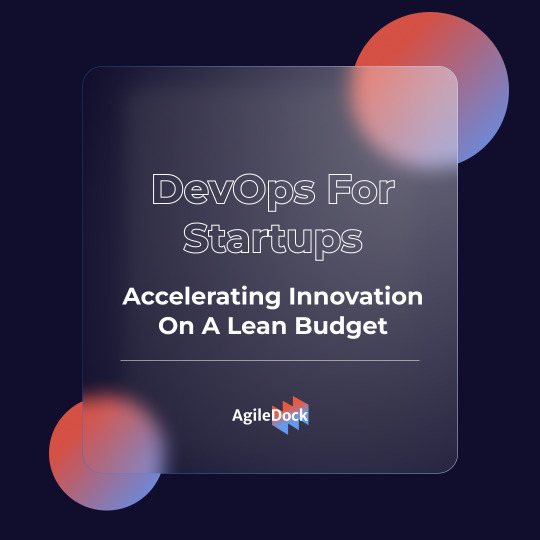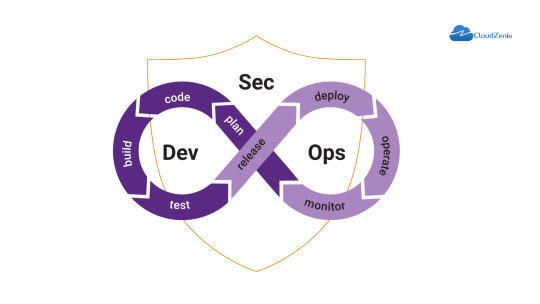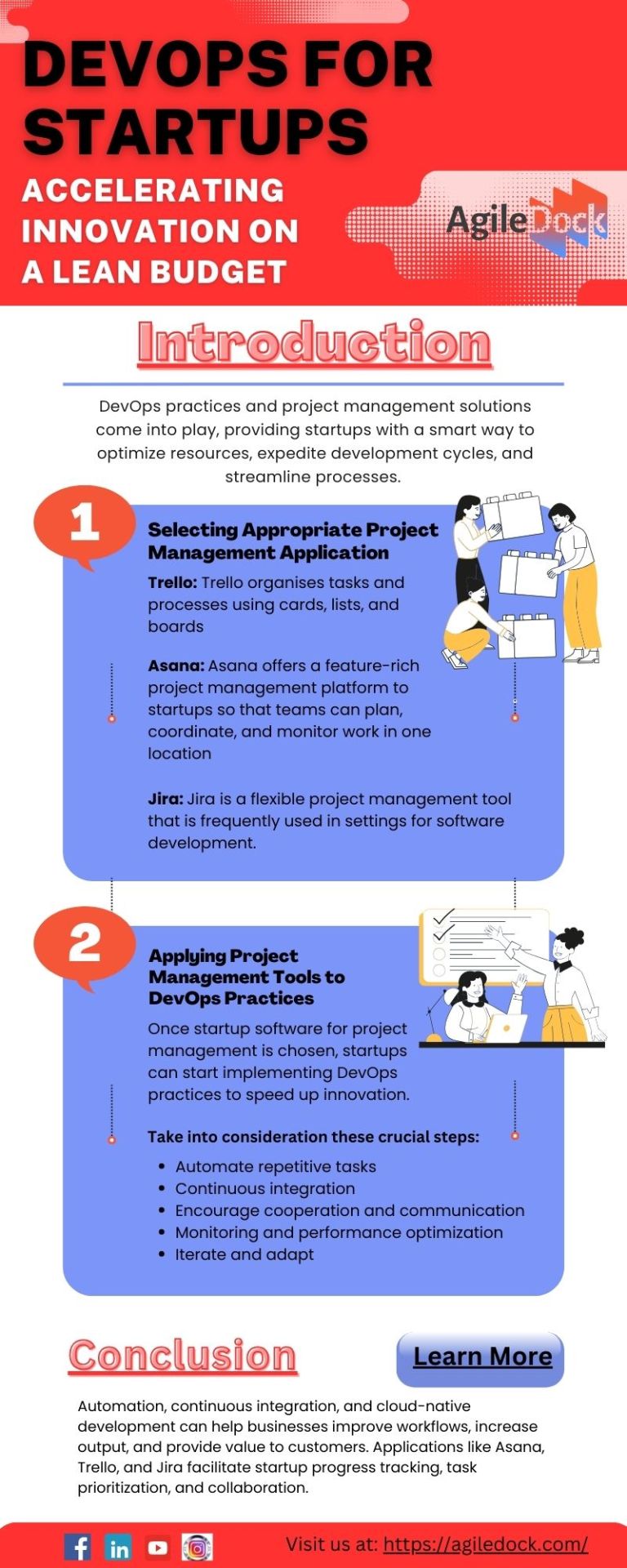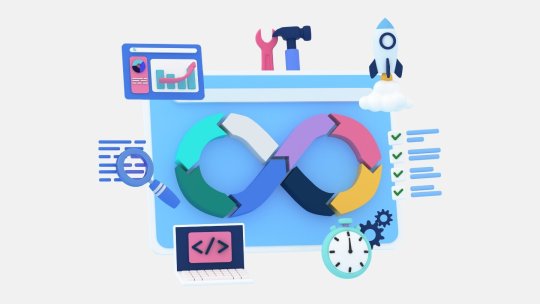#DevOps Practices
Explore tagged Tumblr posts
Text
Trends to Follow for Staunch Scalability In Microservices Architecture

Scalability in microservices architecture isn’t just a trend—it’s a lifeline for modern software systems operating in unpredictable, high-demand environments. From streaming platforms handling millions of concurrent users to fintech apps responding to real-time transactions, scaling right means surviving and thriving.
As a software product engineering service provider, we’ve witnessed how startups and enterprises unlock growth with a scalable system architecture from day 1. It ensures performance under pressure, seamless deployment, and resilience against system-wide failures.
And as 2025 brings faster digital transformation, knowing how to scale smartly isn’t just beneficial—it’s vital.
At Acquaint Softtech, we don’t just write code—we craft scalable systems!
Our team of expert engineers, DevOps specialists, and architectural consultants work with you to build the kind of microservices infrastructure that adapts, survives, and accelerates growth.
Let Talk!
Why Scalability in Microservices Architecture Is a Game-Changer
Picture this: your product’s user base doubles overnight. Traffic spikes. Transactions shoot up. What happens?
If you're relying on a traditional monolithic architecture, the entire system is under stress. But with microservices, you’re only scaling what needs to be scaled!
That’s the real power of understanding database scalability in microservices architecture. You’re not just improving technical performance, you’re gaining business agility!
Here’s what that looks like for you in practice:
Targeted Scaling: If your search service is flooded with requests, scale that single microservice without touching the rest!
Fail-Safe Systems: A failure in your payment gateway won’t crash the whole platform—it’s isolated.
Faster Deployments: Teams can work on individual services independently and release updates without bottlenecks.
📊 Statistics to Know:
According to a 2024 Statista report, 87% of companies embracing microservices list scalability as the #1 reason for adoption—even ahead of speed or modularity. Clearly, modern tech teams know that growth means being ready.
Scalability in microservices architecture ensures you’re ready—not just for today’s demand but for tomorrow’s expansion.
But here’s the catch: achieving that kind of flexibility doesn’t happen by chance!
You need the right systems, tools, and practices in place to make scalability effortless. That’s where staying updated with current trends becomes your competitive edge!
Core Principles that Drive Scalability in Microservices Architecture
Understanding the core fundamentals helps in leveraging the best practices for scalable system architecture. So, before you jump into trends, it's essential to understand the principles that enable true scalability.
Without these foundations, even the most hyped system scalability tools and patterns won’t get you far in digital business!
1. Service Independence
It's essential for each microservice to operate in isolation. Decoupling allows you to scale, deploy, and debug individual services without impacting the whole system.
2. Elastic Infrastructure
Your system must incorporate efficient flexibility with demand. Auto-scaling and container orchestration (like Kubernetes) are vital to support traffic surges without overprovisioning.
3. Smart Data Handling
Scaling isn’t just compute—it’s efficient and smart data processing. Partitioning, replication, and eventual consistency ensure your data layer doesn’t become the bottleneck.
4. Observability First
Monitoring, logging, and tracing must be built in within every system to be highly scalable. Without visibility, scaling becomes reactive instead of strategic.
5. Built-in Resilience
Your services must fail gracefully, if its is destined to. Circuit breakers, retries, and redundancy aren’t extras—they’re essentials at scale.
These principles aren’t optional—they’re the baseline for every modern system architecture. Now you’re ready to explore the trends transforming how teams scale microservices in 2025!
Top Trends for Scalability in Microservices Architecture in 2025
As microservices continue to evolve, the focus on scalability has shifted from simply adding more instances to adopting intelligent, predictive, and autonomous scaling strategies. In 2025, the game is no longer about being cloud-native—it’s about scaling smartly!
Here are the trends that are redefining how you should approach scalability in microservices architecture.
🔹 1. Event-Driven Architecture—The New Default
Synchronous APIs once ruled microservices communication. Today, they’re a bottleneck. Event-driven systems using Kafka, NATS, or RabbitMQ are now essential for high-performance scaling.
With asynchronous communication:
Services don’t wait on each other, reducing latency.
You unlock horizontal scalability without database contention.
Failures become less contagious due to loose coupling.
By 2025, over 65% of cloud-native applications are expected to use event-driven approaches to handle extreme user loads efficiently. If you want to decouple scaling from system-wide dependencies, this is no longer optional—it’s foundational.
🔹 2. Service Mesh for Observability, Security, & Traffic Control
Managing service-to-service communication becomes complex during system scaling. That’s where service mesh solutions like Istio, Linkerd, and Consul step in.
They enable:
Fine-grained traffic control (A/B testing, canary releases)
Built-in security through mTLS
Zero-instrumentation observability
A service mesh is more than just a networking tool. It acts like the operating system of your microservices, ensuring visibility, governance, and security as you scale your system. According to CNCF's 2024 report, Istio adoption increased by 80% year-over-year among enterprises with 50+ microservices in production.
🔹 3. Kubernetes Goes Fully Autonomous with KEDA & VPA
Though Kubernetes is the gold standard for orchestrating containers, managing its scaling configurations manually can be a tedious job. That’s where KEDA (Kubernetes Event-Driven Autoscaling) and VPA (Vertical Pod Autoscaler) are stepping in.
These tools monitor event sources (queues, databases, API calls) and adjust your workloads in real time, ensuring that compute and memory resources always align with demand. The concept of the best software for automated scalability management say that automation isn't just helpful—it’s becoming essential for lean DevOps teams.
🔹 4. Edge Computing Starts to Influence Microservices Design
As latency-sensitive applications (like real-time analytics, AR/VR, or video processing) become more common, we’re seeing a shift toward edge-deployable microservices!
Scaling at the edge reduces the load on central clusters and enables ultra-fast user experiences by processing closer to the source. By the end of 2025, nearly 40% of enterprise applications are expected to deploy at least part of their stack on edge nodes.
🔹 5. AI-Powered Scaling Decisions
AI-driven autoscaling based on the traditional metrics ensures a more predictive approach. Digital platforms are now learning from historical traffic metrics, usage patterns, error rates, and system load to:
Predict spikes before they happen
Allocate resources preemptively
Reduce both downtime and cost
Think: Machine learning meets Kubernetes HPA—helping your system scale before users feel the lag. Great!
Modern Database Solutions for High-Traffic Microservices
Data is the bloodstream of your system/application. Every user interaction, transaction, or API response relies on consistent, fast, and reliable access to data. In a microservices environment, things get exponentially more complex as you scale, as each service may need its separate database or shared access to a data source.
This is why your choice of database—and how you architect it—is a non-negotiable pillar in the system scaling strategy. You're not just selecting a tool; you're committing to a system that must support distributed workloads, global availability, real-time access, and failure recovery!
Modern database systems must support:
Elastic growth without manual intervention
Multi-region deployment to reduce latency and serve global traffic
High availability and automatic failover
Consistency trade-offs depending on workload (CAP theorem realities)
Support for eventual consistency, sharding, and replication in distributed environments
Now, let’s explore some of the top database solutions for handling high traffic—
MongoDB
Schema-less, horizontally scalable, and ideal for rapid development with flexible data models.
Built-in sharding and replication make it a go-to for user-centric platforms.
Cassandra
Distributed by design, Cassandra is engineered for write-heavy applications.
Its peer-to-peer architecture ensures zero downtime and linear scalability.
Redis (In-Memory Cache/DB)
Blazing-fast key-value store used for caching, session management, and real-time analytics.
Integrates well with primary databases to reduce latency.
CockroachDB
A distributed SQL database that survives node failures with no manual intervention.
Great for applications needing strong consistency and horizontal scale.
YugabyteDB
Compatible with PostgreSQL, it offers global distribution, automatic failover, and multi-region writes—ideal for SaaS products operating across continents.
PostgreSQL + Citus
Citus transforms PostgreSQL into a horizontally scalable, distributed database—helpful for handling large analytical workloads with SQL familiarity.
Amazon Aurora
A managed, high-throughput version of MySQL and PostgreSQL with auto-scaling capabilities.
Perfect for cloud-native microservices with relational needs.
Google Cloud Spanner
Combines SQL semantics with global horizontal scaling.
Offers strong consistency and uptime guarantees—ideal for mission-critical financial systems.
Vitess
Used by YouTube, Vitess runs MySQL underneath but enables sharding and horizontal scalability at a massive scale—well-suited for read-heavy architectures.
Bottomline
Scaling a modern digital product requires more than just technical upgrades—it demands architectural maturity. Scalability in microservices architecture is built on clear principles of—
service independence,
data resilience,
automated infrastructure, and
real-time observability.
Microservices empower teams to scale components independently, deploy faster, and maintain stability under pressure. The result—Faster time to market, better fault isolation, and infrastructure that adjusts dynamically with demand.
What truly validates this approach are the countless case studies on successful product scaling from tech companies that prioritized scalability as a core design goal. From global SaaS platforms to mobile-first startups, the trend is clear—organizations that invest early in scalable microservices foundations consistently outperform those who patch their systems later.
Scalability in microservices architecture starts with the right foundation—not reactive fixes. Consult the software experts at Acquaint Softtech to assess and align your system for scale. Contact us now to start building with long-term resilience in mind.
Get in Touch
FAQs
1. What is scalability in microservices architecture?
Scalability in microservices architecture refers to the ability of individual services within a system to scale independently based on workload. This allows you to optimize resource usage, reduce downtime, and ensure responsiveness during high-traffic conditions. It enables your application to adapt dynamically to user demand without overburdening the entire system.
2. Why are databases critical in scalable architectures?
A scalable system is only as strong as its data layer. If your services scale but your database can't handle distributed loads, your entire application can face performance bottlenecks. Scalable databases offer features like replication, sharding, caching, and automated failover to maintain performance under pressure.
3. What are the best practices for automated scalability?
Automated scalability involves using tools like Kubernetes HPA, KEDA, and VPA to auto-adjust resources based on real-time metrics. Best practices also include decoupling services, setting scaling thresholds, and implementing observability tools like Prometheus and Grafana. We just disclosed them all in the blog above!
4. Are there real-world case studies on successful product scaling?
Yes, many leading companies have adopted microservices and achieved remarkable scalability. For instance, Netflix, Amazon, and Uber are known for leveraging microservices to scale specific features independently. At Acquaint Softtech, we’ve also delivered tailored solutions backed by case studies on successful product scaling for startups and enterprises alike. Get in touch with our software expert to know more!
#Microservices#Cloud Computing#Software Product Engineering#System Architecture#Database Scalability#DevOps Practices
0 notes
Text
#Software Development Trends#Top Tech Trends#IT Innovation#Agile Development#DevOps Practices#Digital Transformation#Emerging Technologies#Cloud Computing#Custom Software Trends#Future of Software Development
1 note
·
View note
Text
Harnessing Containerization in Web Development: A Path to Scalability
Explore the transformative impact of containerization in web development. This article delves into the benefits of containerization, microservices architecture, and how Docker for web apps facilitates scalable and efficient applications in today’s cloud-native environment.
#Containerization in Web Development#Microservices architecture#Benefits of containerization#Docker for web apps#Scalable web applications#DevOps practices#Cloud-native development
0 notes
Text
12-Factor App Methodology: Essential Web Development Best Practices for Modern Apps
Explore the 12-Factor App Methodology and uncover web development best practices that enhance scalability and maintainability. This comprehensive guide delves into 12-Factor App Principles, offering insights into effective software development methodologies and their impact on cloud-native applications.
#12-Factor App Methodology#Web Development Best Practices#12-Factor App Principles#Software Development Methodologies#Cloud-Native Applications#DevOps Practices
0 notes
Text
Scaling Node.js Applications with PM2
Scaling Node.js Applications with PM2: A Comprehensive Guide
Introduction As your Node.js application grows, you may need to scale it to handle increased traffic and ensure reliability. PM2 (Process Manager 2) is a powerful process manager for Node.js applications that simplifies deployment, management, and scaling. It provides features such as process monitoring, log management, and automatic restarts, making it an essential tool for production…
#application scaling#deployment#DevOps practices#monitoring#Node.js#Node.js scaling#PM2#process management#web development
0 notes
Text
How DevOps Practices Improve Agile Software Development
Agile software development is a methodology focused on iterative progress, collaboration, and adaptability to change. It emphasizes delivering small, functional pieces of software frequently, allowing for continuous feedback and improvement. DevOps practices involve integrating development and operations teams to streamline workflows, enhance communication, and automate processes. This approach aims to improve software quality and accelerate delivery timelines.
0 notes
Text

Navigating DevOps Practices in Startup Ventures
Delve into the strategies and project management solutions powering successful startup journeys. Explore how innovative DevOps practices enable efficient resource allocation, seamless collaboration, and accelerated time-to-market, propelling emerging companies towards sustainable growth and market leadership. Visit here - https://bit.ly/3vJt7Rj
#project management software#project management solution#project management tool#DevOps practices#devops practices startups
0 notes
Text
Uncover the revolutionary synergy between AI and DevOps infrastructure in this in-depth analysis. Explore transformative insights for unparalleled efficiency. Dive into the future of seamless collaboration!
#AI Integration Into DevOps Methodologies#AI Into DevOps Infrastructure#AI Into DevOps Techniques#AI-Driven Analytics#DevOps Infrastructure#DevOps Methodologies#DevOps Practices#DevOps Strategies#Future Of AI-Driven DevOps#Implementing AI In DevOps#Software Development Landscape
0 notes
Text
Uncover the evolution of DevOps with AI's transformative touch. Dive deep into a comprehensive analysis, unlocking the future of agile infrastructure. Engage with innovation in every byte!
#AI Integration Into DevOps Methodologies#AI Into DevOps Infrastructure#AI Into DevOps Techniques#AI-Driven Analytics#DevOps Infrastructure#DevOps Methodologies#DevOps Practices#DevOps Strategies#Future Of AI-Driven DevOps#Implementing AI In DevOps#Software Development Landscape
0 notes
Text
Explore the transformative synergy of AI and DevOps, driving innovation and efficiency in software development. Unleash the power of intelligent automation.
#AI Integration Into DevOps Methodologies#AI Into DevOps Infrastructure#AI Into DevOps Techniques#AI-Driven Analytics#DevOps Infrastructure#DevOps Methodologies#DevOps Practices#DevOps Strategies#Future Of AI-Driven DevOps#Implementing AI In DevOps#Software Development Landscape
0 notes
Text
Explore the transformative synergy of AI and DevOps, driving innovation and efficiency in software development. Unleash the power of intelligent automation.
#AI Integration Into DevOps Methodologies#AI Into DevOps Infrastructure#AI Into DevOps Techniques#AI-Driven Analytics#DevOps Infrastructure#DevOps Methodologies#DevOps Practices#DevOps Strategies#Future Of AI-Driven DevOps#Implementing AI In DevOps#Software Development Landscape
0 notes
Text
Explore the transformative synergy of AI and DevOps, driving innovation and efficiency in software development. Unleash the power of intelligent automation.
#AI Integration Into DevOps Methodologies#AI Into DevOps Infrastructure#AI Into DevOps Techniques#AI-Driven Analytics#DevOps Infrastructure#DevOps Methodologies#DevOps Practices#DevOps Strategies#Future Of AI-Driven DevOps#Implementing AI In DevOps#Software Development Landscape
0 notes
Text
Shift Left, Save Resources: DevSecOps and the CI/CD Pipeline

The power of "Shift Left, Save Resources: DevSecOps and the CI/CD Pipeline"! Discover how this approach not only enhances software development and delivery but also strengthens security measures. Let's optimize efficiency while safeguarding our digital assets. Read more: https://medium.com/@cloudzenixllc/shift-left-save-resources-devsecops-and-the-ci-cd-pipeline-3c9d5d5264b7
#DevSecOps#devops solutions and services#devops development company#devops service company in india#cloud migration#devops practices#devops service provider#devops#cloud solutions#cloud services#cloud
0 notes
Text

Elevate Your Startup Journey With Agilledock Guide on DevOps Practices
Dive into the world of DevOps practices tailored for startups with AgileDock's innovative solutions. Learn how their project management software and tools streamline operations, optimize resources, and drive rapid innovation, all within budget constraints.
#project management software#project management solution#project management tool#devOps practices#devops practices startups
0 notes
Text
DevOps Platforms And Software Development

28 Best DevOps Platforms And Tools: The ULTIMATE Guide
These best DevOps platforms and software can be a game-changer for businesses aiming to streamline their software deployment and development processes. The right platform or tool automates tasks and boosts collaboration between the operations and development teams. This, in turn, leads to quicker deployment of high-quality software that meets user expectations. Selecting from the Best DevOps Platforms and Software requires understanding your team's specific needs and how each tool can address them effectively. Tech Ahead provides cutting-edge DevOps platforms and software development solutions to streamline and enhance the software delivery lifecycle.
Understanding DevOps Platforms and Software
'DevOps' amalgamates two pivotal roles in software development: Development (Dev) and Operations (Ops). It's a methodology that encourages collaboration between these traditionally separate teams to streamline the entire software development lifecycle. Focusing on DevOps platforms and tools, they are integrated systems designed to support this collaborative approach by automating many routine tasks involved in developing applications from design through deployment stages.
Purpose of DevOps Tools
A range of specialized DevOps tools have been developed for different aspects of DevOps practices. Some handle code creation, while others manage testing or deployment processes. These popular DevOps automation tools enable faster releases with fewer errors due to their automation capabilities at various stages. Besides accelerating release cycles, these open-source DevOps tools also promote better communication among operations teams, thus fostering a culture where continuous improvement becomes part of everyday work habits within agile software development environments.
Monitoring and Error Reporting Platforms: The Backbone of App Performance
The effectiveness of a web app or mobile application is essential for its success. Monitoring and error reporting platforms are the backbones for maintaining this performance, offering tools that track application behavior, detect anomalies, and diagnose issues in real time.
Let's dive into these top 28 Best DevOps Platforms and Tools:
Raygun: Comprehensive Error Tracking
Nagios: Pioneer in IT Infrastructure Monitoring
Firebase Crashlytics: Specialized Mobile App Support
Opsgenie by Atlassian
Puppet Enterprise: The Model-Driven Approach
Cooking up Configurations with Progress Chef
An Open Source Solution: Ansible
SysAid: An All-Rounder In Configuration Management
Jenkins: A Versatile Open-Source Tool
Bamboo: Seamless Release Management
Amazon ECS: Containerized Deployments Simplified
Octopus Deploy: Advanced Deployment Functionalities
CircleCI: Speedy Builds And Tests
Docker: A Popular DevOps Tool
Redhat Openshift: Enterprise-Grade Solution
Kubernetes: The Container Orchestration King
LXC/LXD: Linux-Based Virtualization
Git: A Leading SCM Tool
Mercurial: User-friendly SCM
Apache (SVN) Subversion
SonarQube
Jira
Gradle
Atlassian Open DevOps
Azure DevOps Services
AWS (Amazon Web Services) DevOps
Terraform: An Open-Source Tool for Infrastructure Management
Google Cloud Build: Streamlining Continuous Integration/Continuous Deployment
TechAhead: Pioneering Global Excellence In The Field Of Development Work With Best-in-class Software
An industry leader in this domain - TechAhead has earned global recognition for their expertise in developing high-performing digital products using these best-in-class DevOps Platforms and software. They understand the importance of selecting appropriate DevOps automation tools tailored to client requirements, ensuring efficient workflow throughout the entire software development lifecycle. Their commitment to quality deliverables sets them apart, making them a one-stop solution provider for all application and software development automation needs.
Navigating numerous options might seem daunting, but it becomes easier to pick suitable ones once you identify what your team requires. No two projects are alike, so finding the right fit for your needs is essential. And if you ever find yourself needing expert guidance, remember companies like TechAhead are always ready to help.
The DevOps landscape is vast and diverse, with many platforms and software tools available to facilitate the development, deployment, monitoring, and maintenance of web apps and mobile applications. These popular DevOps tools are essential in streamlining operations teams' workflows while fostering collaboration among DevOps teams.
Conclusion
Exploring the world of DevOps platforms and software can feel like navigating a labyrinth. But, with this comprehensive guide, you've been armed with knowledge about top tools in various categories - from monitoring to DevOps configuration management tools, CI/CD deployment, and containerization. We've dived into source code management and build tools while shedding light on cloud-based solutions. We even touched upon security essentials for your applications.
The key takeaway? No single answer fits all when it comes to the best DevOps tools. It all concerns what works best with your team's needs and workflow. Understanding these Best DevOps Platforms and Software is part of the journey towards efficient software development. The real magic happens when you leverage them effectively. Contact TechAhead today for all your DevOps development, web, and mobile app development!
#https://www.techaheadcorp.com/blog/best-devops-platforms-software/#DevOps tools#DevOps practices#DevOps solutions#DevOps automation frameworks#DevOps software stack#DevOps security tools#Best DevOps Platforms and software#DevOps Platforms and Software#DevOps Platforms and Software Development#DevOps Platforms#DevOps Platforms Tools#TechAhead Corp#TechAheadCorp#techaheadcorp.com
0 notes
Text
Django and Docker: Containerizing Applications
Containerizing Django Applications with Docker: A Comprehensive Guide
Introduction Docker is a powerful tool that allows developers to create, deploy, and run applications in containers. Containers are lightweight, portable, and consistent environments that include everything needed to run an application, from the operating system to the code, runtime, libraries, and dependencies. This article will guide you through the process of containerizing a Django…
#containerizing Django#DevOps practices#Django Docker integration#Docker Compose#Docker Django setup#Python web development
0 notes